Mammalia Characteristics
- Presence of hair (endothermy)
- Mammary glands
- 3 inner ear bones
- Dentary-squamosal jaw articulation
- Heterodont dentition (varied teeth)
- Presence of pinnae (external ears)
- Diaphragm and 4-chambered heart
|
|
Subclass Prototheria — Monotremes
Characteristics
- Most primitive extant mammals
- Lay eggs
- Mammary glands lack nipples
- Lack pinnae (external ears)
|
Order Monotremata
- Echidnas and Platypus
- Only extant order in Subclass
- 5 living species are highly specialized, toothless
|
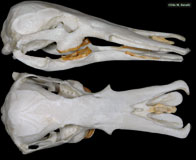
Duck-billed Platypus Ornithorhynchus anatinus (Family Ornithorhynchidae), skull
Diet: aquatic invertebrates, worms
|

Duck-billed Platypus Ornithorhynchus anatinus (Family Ornithorhynchidae), taxidermy mount

Short-nosed Echidna Skull, Tachyglossus aculeatus (Family Tachyglossidae)
Diet: ants, termites
|
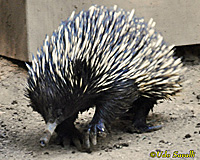
Short-nosed Echidna, Tachyglossus aculeatus (Family Tachyglossidae)
|
|
Subclass Allotheria — Multituberculates & Relatives
Order Multituberculata
- Extinct: lived from late Jurassic to late Eocene (160 Ma to 35 Ma)
- Diverse and successful during Cretaceous and early Paleogene Periods
- Skulls superficially rodent-like
- Characterized by molars with large number of cusps, typically arranged in a double row
|
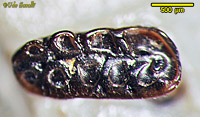
Fossil molar of Mesodma formosa (Family Neoplagiaulacidae); Late Cretaceous Period, South Dakota
|

A Multituberculate, Catopsbaatar catopsaloides (Family Djadochtatheriidae);
Source: Kielan-Jaworowska & Hurum 2006. Acta Palaeontologica Polonica. Creative Commons Attribution 2.0
|
|
Subclass Metatheria — Marsupials
Characteristics
- Young complete development in pouch
- Maximum dental formula: 5/4, 1/1, 3/3, 4/4
- More complex limb musculature
- Angle of jaw bends inward
- 400 species in Neotropics, Australian region
- There are 4 additional orders not shown below nor represented in lab
|
Order Didelphimorphia
- American Opossums
- Diverse habitats
- Most are omnivorous
- 5/4 incisors per side is unique
- Sagittal crest (along skull midline) usually present
- Neotropics to southern U.S.
|
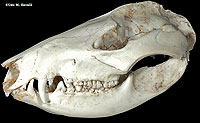
Virginia Opossum Skull, Didelphis virginiana (Family Didelphidae)
Diet: omnivore
|
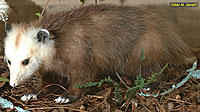
Virginia Opossum, Didelphis virginiana (Family Didelphidae); taxidermy mount
|
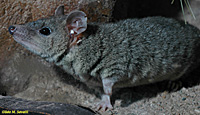
Shorttailed Opossum, Monodelphis domestica (Family Didelphidae)
|
|
Order Dasyuromorphia
- Marsupial Mice, Quolls, Tasmanian Devil, etc.
- Most are insectivorous or carnivorous
- 4 upper incisors per side; large canines
- Sagittal crest usually absent
- Australasian Region
|
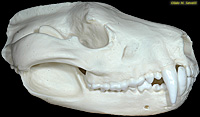
Tasmanian Devil Skull, Sarcophilus harrisii (Family Dasyuridae)
Diet: vertebrates
|
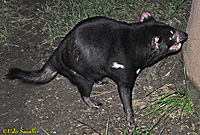
Tasmanian Devil, Sarcophilus harrisii (Family Dasyuridae)
|
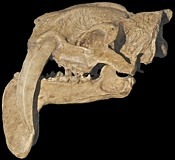
Saber-toothed Marsupial Skull Fossil, Thylacosmilus† sp. (Family Thylacosmilidae)
Diet: large vertebrates
|

Eastern Quoll, Dasyurus viverrinus, taxidermy mount (Family Myrmecobiidae);
|

Numbat skull, Myrmecobius fasciatus (Family Myrmecobiidae)
Diet: termites
|

Numbat, Myrmecobius fasciatus, taxidermy mount (Family Dasyuridae);
|
|
Order Diprotodontia
- Kangaroos, Wallabies, Koalas, Wombats, etc.
- Mostly herbivorous or omnivorous
- Includes largest marsupials
- Note broad grinding molars, diastema
- Australia
|
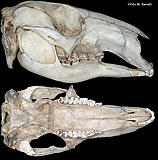
Kangaroo skull, Macropus sp. (Family Macropodidae)
|
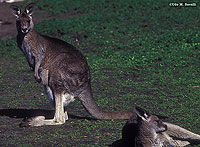
Eastern Gray Kangaroo, Macropus giganteus (Family Macropodidae)
|
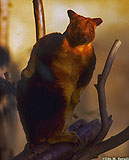
Goodfellow's Tree Kangaroo, Dendrolagus matschiei (Family Macropodidae)
|
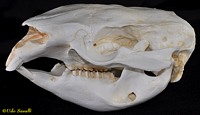
Common Wombat skull, Vombatus ursinus (Family Vombatidae)
|
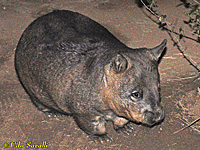
Southern Hairy-nosed Wombat, Lasiorhinus latifrons (Family Vombatidae)
|
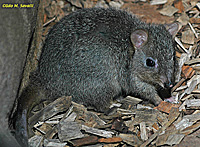
Brush-tailed Bettong, Bettongia penicillata (Family Potoroidae)
|
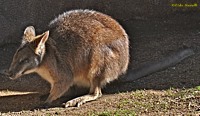
Parma Wallaby, Macropus parma (Family Macropodidae)
|
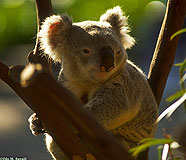
Koala, Phascolarctos cinereus (Family Phascolarctidae)
|
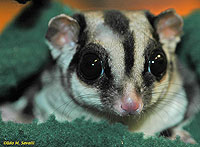
Sugar Glider, Petaurus breviceps (Family Petauridae)
|
|
Subclass Eutheria — Placental Mammals
Characteristics
- Extended gestation with complex placenta
- Maximum dental formula: 3/3, 1/1, 4/4, 3/3
- Morphologically very diverse
- 6170 species, worldwide
|
|
Clade Afrotheria
- A monophyletic grouping that branched off near the base of the Placental mammal tree
- Primarily African distribution
- Very diverse in body form and lifestyle
- Characterized by high number of vertebrae
- Permanent teeth erupt relatively late
- Many have a long, mobile snout
- 90 species total in 6 extant orders (including the Proboscidia listed below)
|

West Indian Manatee, Trichechus manatus; Order Sirenia: FL
|
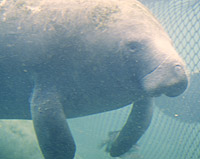
West Indian Manatee, Trichechus manatus; Order Sirenia: FL
|
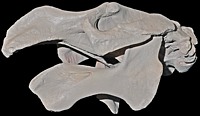
Steller's Sea Cow† Skull, Hydrodamalis gigas; Order Sirenia
Diet: kelp (sea weed)
|
|
|
|
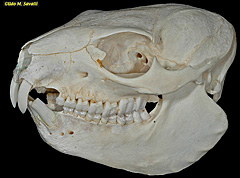
Rock Hyrax skull, Procavia capensis; Order Hyracoidea
Diet: herbivore
|
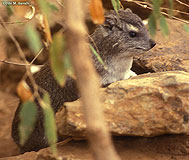
Yellow-spotted Hyrax, Heterohyrax brucei; Order Hyracoidea; Kenya
|
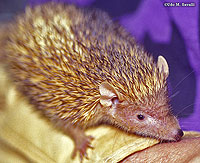
Lesser Tenrec, Echinops telfairi; Order Afrosoricida
|
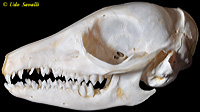
Four-toed Elephant Shrew skull, Petrodromus tetradactylus; Order Macroscelidea
Diet: insects
|
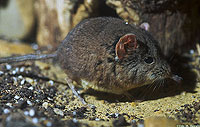
Round-eared Elephant Shrew, Macroscelides proboscideus; Order Macroscelidea
|

Aardvark skull, Orycteropus afer; Order Tubulidentata
Diet: termites
|

Aardvark, Orycteropus afer, taxidermy mount; Order Tubulidentata
|
Order Proboscidia
- Elephants
- Part of Clade Afrotheria (above)
- Huge size
- Upper incisors enlarged into tusks
- Molars formed of fused vertical plates that are replaced front to back
- Nose and upper lip form trunk
- Mostly hairless
- 3 species, Africa, Asia
|
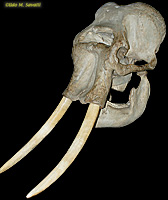
Asian Elephant Skull, Elephas maximus (Family Elephantidae)
San Diego Natural History Museum
|
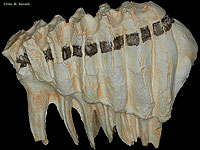
African Elephant molar, Loxodonta africana (length=205 mm)
|
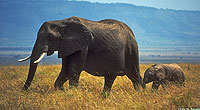
African (Bush) Elephants, Loxodonta africana (Family Elephantidae); Kenya
|
|
Order Xenarthra
- Armadillos, anteaters, sloths
- No canines or incisors
- Cheek teeth small and simple or also absent
- Specialized insectivores
- 38 species; Neotropics
- Taxonomic note: sometimes split into 2 Orders: Pilosa (anteaters + sloths) and Cingulata (armadillos)
|
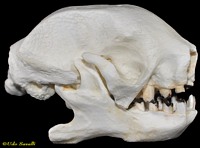
Pale-throated Three-toed Sloth skull, Bradypus tridactylus (Family Bradypodidae)
Diet: herbivore
|
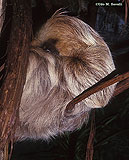
Two-toed Sloth, Choloepus sp. (Family Megalonychidae)
|
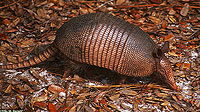
Nine-banded Armadillo, Dasypus novemcinctus (Family Dasypodidae); FL
|

Giant Anteater skull, Myrmecophaga tridactyla (Family Myrmecophagidae)
Diet: ants, termites
|

Giant Anteater, Myrmecophaga tridactyla (Family Myrmecophagidae)
|

Nine-banded Armadillo skull, Dasypus novemcinctus (Family Dasypodidae)
Diet: insects, esp. beetle grubs
|
|
Order Rodentia
- Rodents
- Mostly small size
- 1 pair of continuously growing incisors
- Large diastema between incisors and cheek teeth
- Diverse diets, but majority herbivores, seed-eaters
- Includes 40% of all mammal species
|

Brown Rat skull, Rattus norvegicus (Family Muridae)
See also labeled photo.
Diet: omnivore
|
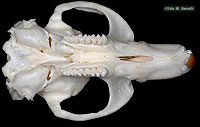
Common Muskrat skull, Ondatra zibethicus (Family Cricetidae)
See also labeled photo.
Diet: herbivore
|
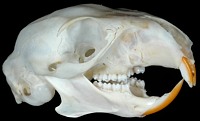
Plantain Squirrel skull, Callosciurus notatus (Family Sciuridae)
Diet: fruits, leaves
|
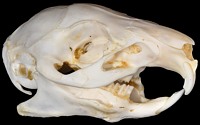
Guinea Pig Skull, Cavia porcellus (Family Caviidae)
Diet: Purina Guinea Pig Chow
|
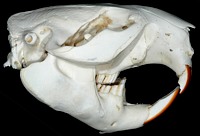
American Beaver skull, Ondatra zibethicus (Family Cricetidae)
Diet: tree bark, aquatic vegetation
|
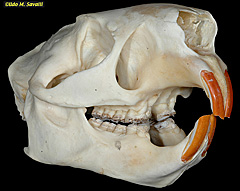
North American Porcupine skull, Erethizon dorsatum (Family Erethizontidae)
Diet: herbivore, esp twigs, bark
|
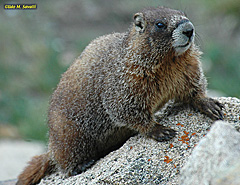
Yellow-bellied Marmot, Marmota flaviventris (Family Sciuridae); CA
|
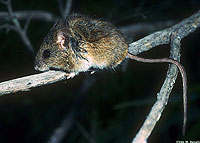
Western Harvest Mouse, Reithrodontomys megalotis (Family Cricetidae); CA
|
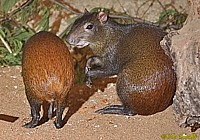
Red-rumped Agouti, Dasyprocta leporina (Family Dasyproctidae)
|
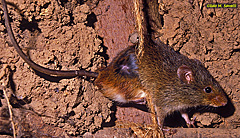
Rusty-nosed Rat, Oenomys hypoxanthus (Family Muridae); Kenya
|
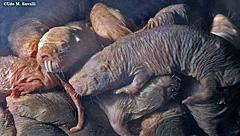
Naked Mole-rats, Heterocephalus glaber (Family Bathyergidae)
|
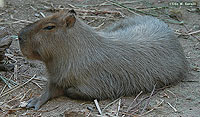
Capybara, Hydrochoerus hydrochaeris (Family Hydrochoeridae), the world's largest rodent (up to 75 kg)
|
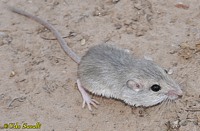
Little Pocket Mouse, Perognathus longimembris (Family Heteromyidae); AZ
|
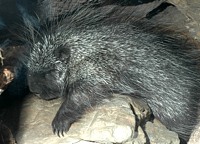
North American Porcupine, Erethizon dorsatum (Family Erethizontidae)
|
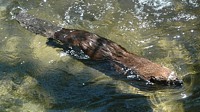
American Beaver, Castor canadensis (Family Castoridae); a semiaquatic rodent
|
|
Order Lagomorpha
- Rabbits and pikas
- Similar to rodents
- Tail very short
- Two pairs of upper incisors (2nd pair behind first)
- Fenestrated skull
- 97 species; worldwide
|
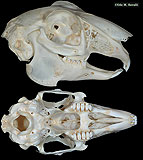
Rabbit Skull, Oryctolagus sp.? (Family Leporidae)
Diet: herbivore
|
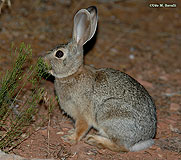
Desert Cottontail, Sylvilagus audubonii (Family Leporidae); CO
|
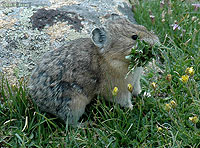
American Pika, Ochotona princeps (Family Ochotonidae); CO
|
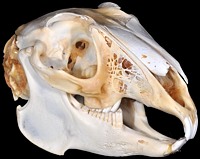
Jackrabbit Skull, Lepus sp. (Family Leporidae)
Diet: herbivore
|
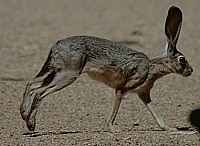
Black-tailed Jackrabbit, Lepus californicus (Family Leporidae); AZ
|
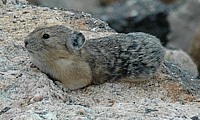
American Pika, Ochotona princeps (Family Ochotonidae); CO
|
|
Minor Orders:
(Order Scandentia)
- Tree shrews
- Generally squirrel-like, but with more binocular vision
- Insectivore-like dentition; large orbits and complete post-orbital bar
- 23 species
(Order Dermoptera)
- Colugos (aka "Flying Lemurs")
- Large, arboreal gliders with membrane between legs
- Large, raised orbit; incisors comb-like
- 2 species
(Order Pholidota)
- Pangolins
- Covered in hard keratin scales
- Limbs short with long claws
- Skull simple; lack teeth
- 8 species
You do not need to know these orders
Order Scandentia:
|
Order Dermoptera:
|
Order Pholidota:
|

Horsfield's Tree Shrew skull, Tupaia javanica (Family Tupaiidae)
Diet: insects
|
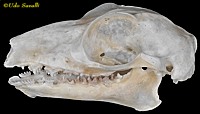
Sunda Colugo skull, Galeopterus variegatus (Family Cynocephalidae)
Diet: herbivore (leaves)
|

Sunda Pangolin skull, Manis javanica (Family Manidae)
Diet: ant/termite specialist
|
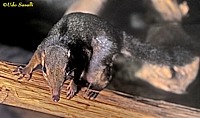
Large Tree Shrew, Tupaia tana (Family Tupaiidae)
|
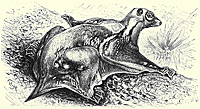
Philippine Colugo, Cynocephalus volans (Family Cynocephalidae)
Source: F. Specht 1927, Brehms Tierleben.
|

Temminck's Pangolin, Manus temmincki, taxidermy mount (Family Manidae)
|
|
Order Primates
- Lemurs, monkeys, apes
- Cheek teeth squarish
- Large, forward-facing eyes
- Reduced muzzle but larger brain
- Grasping hands with nails instead of claws
- 523 species, tropics (humans worldwide)
- Notable subgroups:
- Strepsirhini ("Prosimians" in part) include the more primitive lemurs, bush babies, and lorises.
- Anthropoids are the monkeys, tamarins, marmosets, and apes
- Hominoidea are the lesser apes (gibbons and siamangs) and great apes (orangutans, gorillas, chimps, and humans).
|
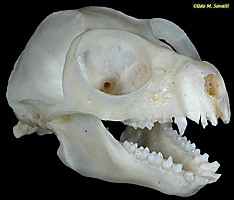
Sunda Slow Loris Skull, Nycticebus coucang (Family Lorisidae)
Diet: tree sap, nectar, fruit
|
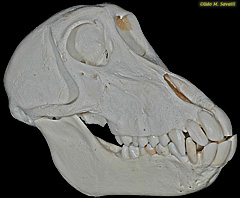
Hamadryas Baboon skull, Papio hamadryas (Family Cercopithecidae)
Diet: omnivore
|
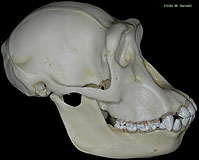
Chimpanzee skull, Pan troglodytes (Family Hominidae)
Diet: fruit, etc.
|
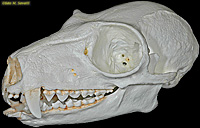
Ruffed Lemur Skull, Varecia variegata (Family Lemuridae)
Diet: fruit
|
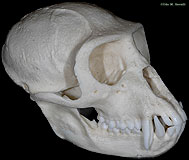
Vervet Monkey Skull, Chlorocebus sp. (Family Cercopithecidae)
See also labeled photo.
Diet: omnivore
|
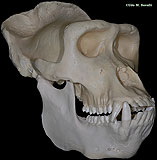
Gorilla skull, male, Gorilla gorilla (Family Hominidae)
Diet: herbivore
|
Strepsirhine "Prosimians":
|
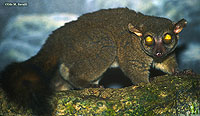
Bush Baby, Galago sp. (Family Galagonidae)
|
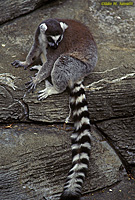
Ring-tailed Lemur, Lemur catta (Family Lemuridae)
|

Coquerel's Sifaka, Propithecus coquereli (Family Indriidae)
|
Ceboidae — New World monkeys, tamarins and marmosets:
|
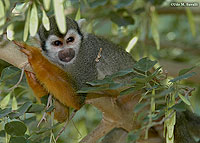
Common Squirrel Monkey, Saimiri sciureus (Family Cebidae)
|
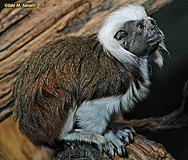
Cotton-top Tamarin, Saguinus oedipus (Family Callitrichidae)
|
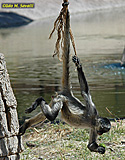
Black-handed Spider Monkey, Ateles geoffroyi (Family Atelidae)
|
Cercopithecoidae — Old World monkeys:
|
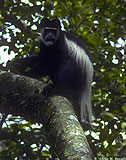
Guereza Colobus, Colobus guereza, Kenya (Family Cercopithecidae)
|
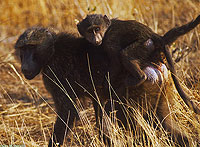
Olive Baboon, Papio anubis, Kenya (Family Cercopithecidae)
|
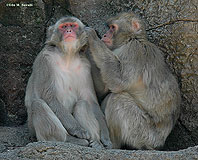
Japanese Macaques, Macaca fuscata (Family Cercopithecidae)
|
Hominoidea — Apes:
|
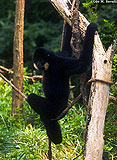
Male Yellow-cheeked Gibbon, Nomascus gabriellae (Family Hylobatidae)
|
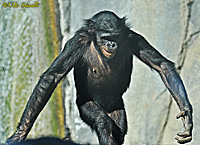
Bonobo, Pan paniscus (Family Hominidae)
|
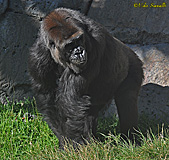
Western Gorilla, Gorilla gorilla (Family Hominidae)
|
|
Order Eulipotyphla
- Shrews, moles, hedgehogs.
- Generalized, ancestral characteristics
- Cusps on cheek teeth tytpically form triangular pattern
- Anterior pair of incisors enlarged
- Canines similar to incisors: tricky to determine dental formula
- Most are small sized
- Relatively small brains
- Pointed snouts with small eyes and ears
- Primarily insectivorous
- Formerly part of polyphyletic Order Insectivora
- 573 species
|
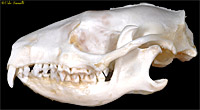
European? Hedgehog skull, Erinaceus sp. (Family Erinaceidae)
Diet: invertebrates, fruit, etc.
|
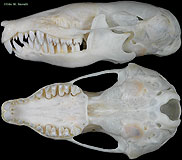
Eastern Mole skull, Scalopus aquaticus (Family Talpidae)
Diet: worms, insects
|

Asian House Shrew skull, Suncus murinus (Family Soricidae)
Diet: insects
|
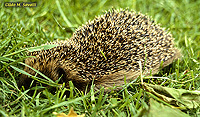
European Hedgehog, Erinaceus europaeus (Family Erinaceidae)
|
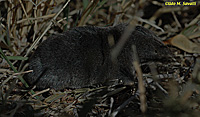
Short-tailed Shrew, Blarina carolinensis? (Family Soricidae)
|
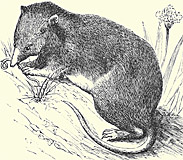
Common Shrew, Sorex araneus (Family Soricidae)
Image in public domain
|
|
Order Chiroptera
- Bats
- Forelimb modified into wing
- Forearm, fingers greatly elongated
- Diet varies, including fruit, insects, nectar
- 1450 species; worldwide
- Two suborders (may not be monophyletic):
- Megachiroptera are the large, tropical fruit bats (aka flying foxes) with limited echolocation
- Microchiroptera are mostly smaller; all use echolocation and are predominantly insectivorous; they often have nose flaps and very large, complex ears
|
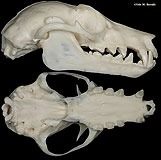
Lyle's Flying Fox skull, Pteropus lylei (Family Pteropodidae)
Diet: fruit
|
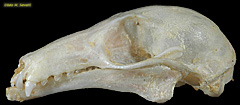
Lesser Dawn Bat skull, Eonycteris spelaea (Family Pteropodidae)
Diet: nectar
|
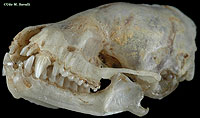
Javan Pipistrelle skull, Pipistrellus javanicus (Family Vespertilionidae)
Diet: insects
|

Hammer-headed Bat skull, Hypsignathus monstrosus (Family Pteropodidae)
Diet: fruit
|

Long-tongued Nectar Bat skull, Macroglossus minimus (Family Pteropodidae)
Diet: nectar
|
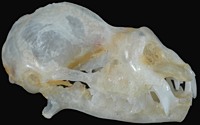
Bicoloured Roundleaf Bat skull, Hipposideros bicolor (Family Vespertilionidae)
Diet: insects
|
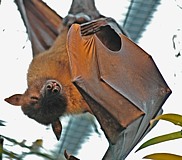
Giant Fruit Bat, Pteropus giganteus (Family Pteropodidae)
|

Rodriguez Fruit Bat, Pteropus rodricensis (Family Pteropodidae)
|
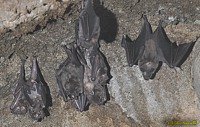
Jamaican Fruit-eating Bats, Artibeus jamaicensis (Family Phyllostomidae)
|
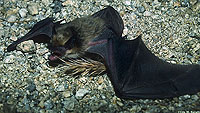
Big Brown Bat, Eptesicus fuscus (Family Vespertilionidae); CA
|
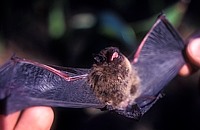
Pipistrelle, Neoromicia sp.?(Family Vespertilionidae); Kenya
|

Hollow-faced Bat, Nycteris sp. (dead) (Family Nycteridae); Kenya
|
|
Order Carnivora
- Dogs, cats, bears, weasels, seals, etc.
- Carnassial dentition: last upper premolar & 1st lower molar form specialized cutting teeth
- Well developed canines
- Most are predators
- Pinnipeds are aquatic, with limbs modified into flippers
- 314 species, now worldwide
|
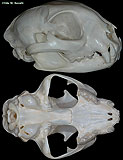
Bobcat skull, Lynx rufus (Family Felidae)
See also labeled photo.
|
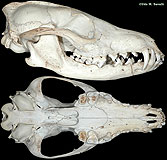
Side-striped Jackal skull, Canis adustus (Family Canidae)
See also labeled photo.
|
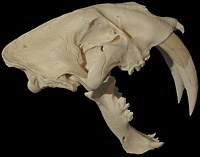
Saber-toothed Cat skull, Smilodon fatalis† (Family Felidae)
|
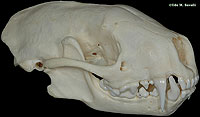
Mink skull, Mustela vison (Family Mustellidae)
|
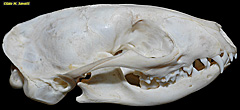
Small Indian Mongoose skull, Herpestes javanicus (Family Herpestidae)
|
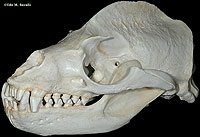
California Sea Lion skull, Zalophus californianus (Family Otariidae)
|

Aardwolf skull, Proteles cristatus (Family Hyaenidae)
|
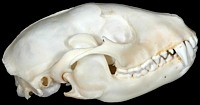
Northern Racoon skull, Procyon lotor (Family Procyonidae)
|
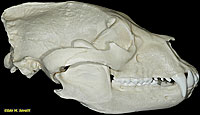
Black Bear skull, Ursus americanus (Family Ursidae)
|
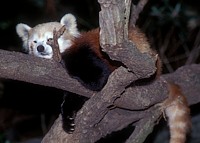
Lesser Panda, Ailurus fulgens (Family Ailuridae)
|
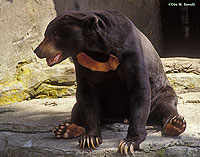
Sun Bear, Helarctos malayanus (Family Ursidae)
|
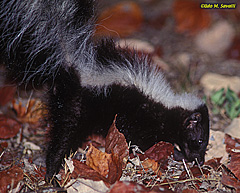
Striped Skunk, Mephitis mephitis (Family Mephitidae)
|
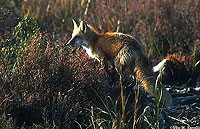
Red Fox, Vulpes vulpes (Family Canidae); CA
|

Banded Mongoose, Mungos mungo (Family Herpestidae)
|

African Lions, Panthera leo (Family Felidae); Kenya
|
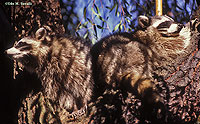
Northern Raccoons, Procyon lotor (Family Procyonidae); CA
|
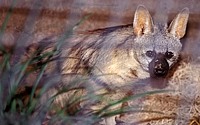
Aardwolf, Proteles cristatus (Family Hyaenidae)
|
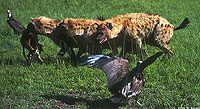
Spotted Hyaenas, Crocuta crocuta (Family Hyaenidae); Kenya
|
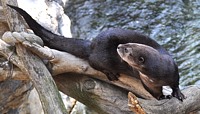
Spot-necked Otter, Hydrictis maculicollis (Family Mustellidae)
|
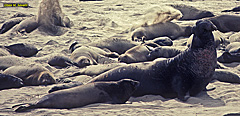
Northern Elephant Seals, Mirounga anguistirostris (Family Phocidae); CA
|
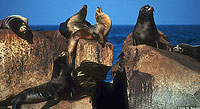
California Sea Lions, Zalophus californianus (Family Otariidae); CA
|
|
Order Perissodactyla
- Odd-toed Ungulates
- 1 or 3 toes per foot
- Large size
- Elongated rostrum
- Herbivorous; hind-gut fermenters
- Unlike Artiodactyls, rhino horns are entirely keratinous and lack a bone core
- 19 species
|
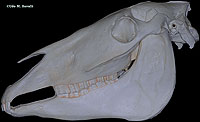
Domestic Horse skull, Equus caballus (Family Equidae)
Diet: herbivore
|
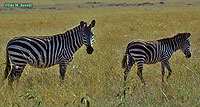
Burchell's Zebras, Equus burchelli (Family Equidae); Kenya
|
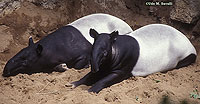
Malayan Tapirs, Tapirus indicus (Family Tapiridae)
|
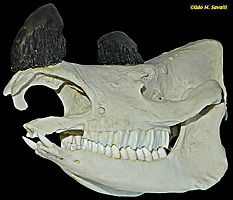
Sumatran Rhinoceros skull, Dicerorhinus sumatrensis (Family Rhinocerotidae)
International Wildlife Museum
Diet: herbivore
|
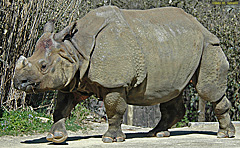
Indian Rhinoceros, Rhinoceros unicornis (Family Rhinocerotidae)
|
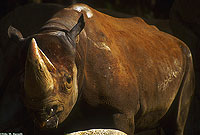
Black Rhinoceros, Diceros bicornis (Family Rhinocerotidae)
|
|
Order Artiodactyla
- Even-toed Ungulates
- 2 or 4 toes per foot
- Diverse in size, shape
- Omnivorous or herbivorous; many are foregut fermenters
- Many have horns, ossicones, or antlers
- 266 species, worldwide
- Taxonomic note: This traditional order is paraphyletic; the clade that includes artiodactyls and whales is called Cetartiodactyla
|
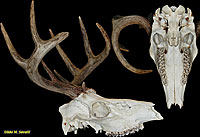
White-tailed Deer skull, Odocoileus virginanus (Family Cervidae), ♂ with antlers
Diet: herbivore
|
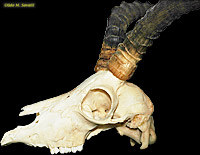
Impala skull, Aepyceros melampus (Family Bovidae), ♂ with horns
Diet: herbivore
|
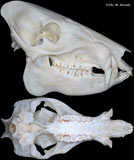
Collared Peccary skull, Pecari (Tayassu) tajacu (Family Tayassuidae)
Diet: herbivorous, omnivorous
|
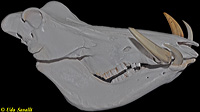
Common Warthog, Phacochoerus africanus (Family Suidae); note tusks
Diet: omnivorous
|
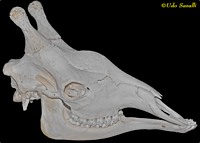
Southern Giraffe skull, Giraffa giraffa (Family Giraffidae), ♂ with ossicones
Diet: herbivorous
|
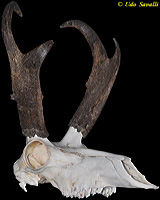
Pronghorn skull, Antilocapra americana (Family Antilocapridae), ♂ with horns
Diet: herbivorous
|
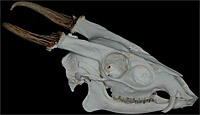
Reeve's Muntjac, Muntiacus reevesi (Family Cervidae)
|
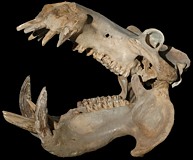
Hippopotamus skull, Hippopotamus amphibius (Family Hippopotamidae)
Diet: herbivorous
|
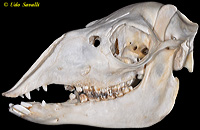
Alpaca skull, Vicugna pacos (Family Camelidae)
Diet: herbivorous
|
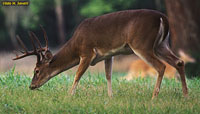
♂ White-tailed Deer, Odocoileus virginianus (Family Cervidae); TX
|

♂ Impala, Aepyceros melampus (Family Bovidae); Kenya
|
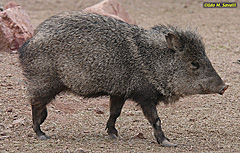
Collared Peccary, Pecari (Tayassu) tajacu (Family Tayassuidae)
|
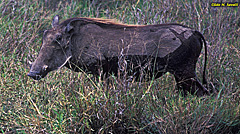
Common Warthog, Phacochoerus africanus (Family Suidae); Kenya
|
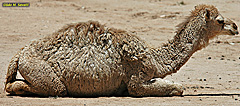
Dromedary, Camelus dromedarius (Family Camelidae)
|
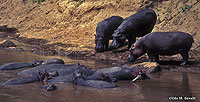
Hippopotamuses, Hippopotamus amphibians (Family Hippopotamidae); Kenya
|
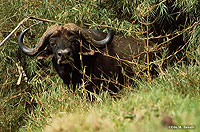
African Buffalo, Syncerus caffer (Family Bovidae); Kenya
|
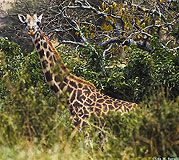
Masai Giraffe, Giraffa tippelskirchi (Family Giraffidae); Kenya
|
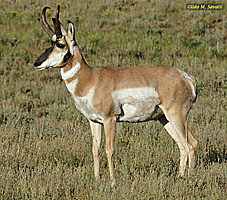
Pronghorn, Antilocapra americana (Family Antilocapridae); WY
|
|
Order Cetacea
- Whales & Dolphins
- Fully aquatic
- Very large size with streamlined shape
- Front flippers; no hind limbs
- Broad crescent-shaped tail fluke
- Nostril on top of head (blowhole)
- Skulls often asymmetric
- 98 species; oceans and some rivers
- Two extant suborders:
- Odontoceti (toothed whales, dolphins) have simple homodont teeth
- Mysticeti (baleen whales) lack teeth but have baleen: keratin sheets used to strain food
|
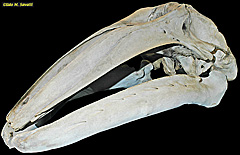
Gray Whale skull, Eschrichtius robustus (Family Eschrichtiidae)
San Diego Natural History Museum
Diet: filter feeder on benthic crustaceans
|
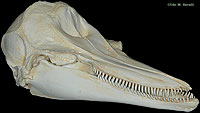
Pacific White-sided Dolphin skull, Lagenorhynchus obliquidens (Family Delphinidae)
Diet: fish
|
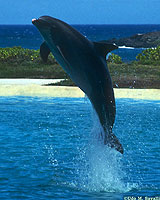
Bottle-nosed Dolphin, Tursiops truncatus (Family Delphinidae)

Bowhead Whale baleen, Balaena mysticetus (Family Balaenidae)
Diet: filter feeder on zooplankton
|

Gray Whale, Eschrichtius robustus (Family Eschrichtiidae)
|
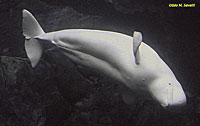
Beluga Whale, Delphinapterus leucas (Family Monodontidae)
| |
|
|




























































































































































